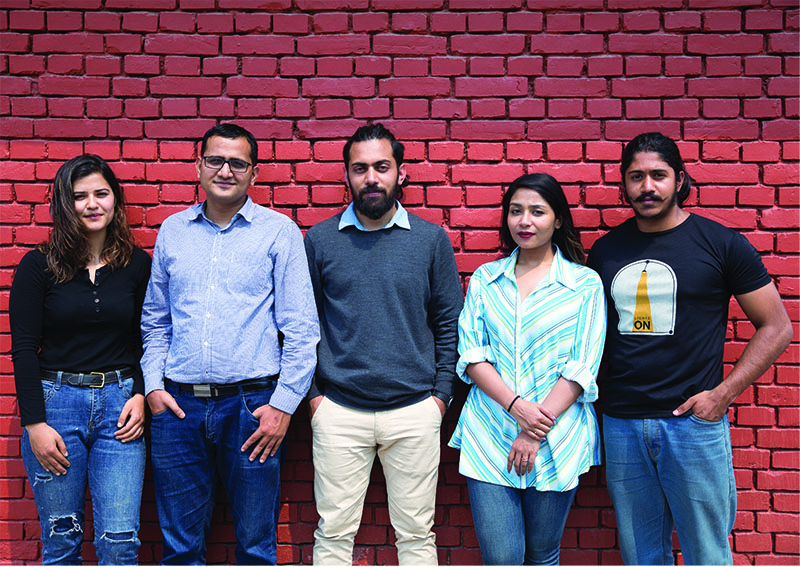
Text by Avant Shrestha Pradip Khatiwada, Founder and Executive Director & Ashutosh Karki, Youth Engagement Team Leader, Youth Innovation Lab shed light on the darkness surrounding street lights and its maintenance.
In recent days, Kathmandu Metropolitan Office has taken measurers to install streetlights in the main areas of the city. However, some alleys and key areas have been neglected altogether. Additionally, timely maintenance of streetlights are lacking giving rise to criminal activities and accidents.
To battle this problem that has sadly become an expected norm of city dwellers lives, Youth Innovation Lab’s (YI- Lab) ‘Lights On’ campaign is an innovative method to try and bring an end to this problem.
‘Lights On’ is an initiative of Youth Innovation Lab to engage youths in a digital advocacy campaign to bring open data and advocacy together for informed decision-making.
Pradip Khatiwada, the Founder and Executive Director of Youth Innovation Lab that was founded in 2016, describes the organisation as a civic take on social enterprise. Khatiwada states, “Basically we use technological tools to merge science and public.” The initial idea behind YI- Lab was not a big one. In fact, the founders attempted to find a local solution for the problems we all are suffering from. “We knew that there were very small problems in the community and we believe that there are solutions within the community level for them,” declares Khatiwada. Moreover, the works that YI-Lab conducts are more focused on the grass-root level. Khatiwada explains, “We try to engage with real problems on the ground and we try to find solutions based on technology for wider benefit”.
For example, sluggish maintenance of roads, air pollution, poor management of public transportation are encumbrances that the public faces on a daily basis, but are often resigned to. Responsible authorities always have an excuse of why it can’t be done or what is hindering the progress. Instead of waiting for problems to be solved, the team at YI-Lab took the initiative to be part of an ecosystem with innovative activity to solve lingering issues; the Lights On movement was started as a small contribution on their part.
Ashutosh Karki, Campaign Coordinator, says, “We launched the Lights On movement on March 2 this year which also happens to be the International Open Data Day.” An interactive event was held where local government representatives, development planning experts, police officials, locals and youths participated in an interactive discussion on data-driven policy decisions, particularly looking at the coverage of street lights at the launch.
Police representatives attributed increase in crime to the darkness.
Additionally Khatiwada explains “Another contributing factor is absence of law. For example, in developed countries if a streetlight is broken the responsible authority will replace or maintain that broken streetlight within 24 hours. But in Nepal when a light is set up, they consider that it is good for a lifetime.” Such is never the case. Everyone agreed that something had to be done. The lights had to be turned on. On the topic of periodic maintenance of streetlights, the campaign is to pressure the metropolitan government to ensure it.
Karki found out that streetlights were the property and responsibility of Kathmandu Metropolitan City and Nepali Electricity Authority. “We started something that uses crowd sourcing for information by using a mobile application,” states Karki. Basically, people who have access to smart phones can input data about streetlights through the ‘Lights On’ platform. Based on the data the team can visualise the availability of streetlights on a particular street/ road/ alley and the status of the light. The condition and its functionality can also be observed on the platform.
The goal of the team is to collect 10,000 data. Karki explains, “With this, we would have the power and credentials to go up to the board and stake our claim with evidence to back us up”. For example, if there is a data about a particular streetlight that is not working, there would be solid proof based on the mapping.
One of the main motives in collecting data is to present it to the Mayor’s office. Khatiwada claims, “We wanted to have strong evidence of 10,000 data. And this is not a competition; the data would be useful to them. We want to help the Mayor do their job better”.
“This is an entirely voluntary program. There is no funding for this. We have NAXA as the co-initiator for this. NAXA voluntary contributes on the technical side and YI lab is the implementing partner collecting data on the ground,” explains Khatiwada.
YI-Lab and NAXA have developed a GIS based mapping application to collect data and developed a portal at http://light.utilitymaps.org/ where all street lights data are stored, made open and visualised as an interactive digital map. The streetlights data are collectable within the Kathmandu Metropolitan City area. Digital volunteers are the key to the success of this initiative. The team is targeting college students as volunteers, but that should not limit-interested volunteers. Unfortunately the app cannot be found for apple users however anyone with a smart phone can download the ‘Lights On’ application from ‘Play Store’. The first step is for the user to register with an email address. The email address is required for a specific code. The email address of the user will also record the amount of data the user has collected. And this will not be visualized or displayed on your web portal, and is confidential. After that the user will be asked to go to the form called ‘Street Lights’ and asked where the streetlight is, ‘in the highway’, ‘streets’ or ‘the alley’. Then the user will be asked if it’s functional or not. Then the user will write the status of the pole. The user can click a picture of the streetlight which is the evidence based data collection and then the user has the GPS coordinates, the precise location of where the streetlights are located. This can be done offline as well and when the users have internet access you can upload the data.
Crowd sourcing and digital volunteers have been key to the ‘Lights On’ campaign. “Digital volunteering simply means you are contributing into the cloud; you do not have to be physically present for the contribution,” clarifies Karki. “Most of our volunteers are students. There are no monetary benefits or anything; the volunteers are involved because they actually care about the campaign and the long-term benefits we can create together. However, the Lights On campaign does reward the volunteers with certificates and T-shirt once they collect 100 streetlights information”, Khatiwada explains. Karki shares, “We have received 2300 data till date and our goal is to reach 10,000 data collection by August”.
Kathmandu as a modern urban city has a huge potential for development, unfortunately the lack of data and spatial information has hindered evidence-based urban development. Since, streetlights are a basic infrastructure that ensures safer mobility and general public safety, the Lights On campaign is an initative to demonstrate the power of volunteer based crowd mapping in helping city officials collect data of utilities and infrastructures in the city.






